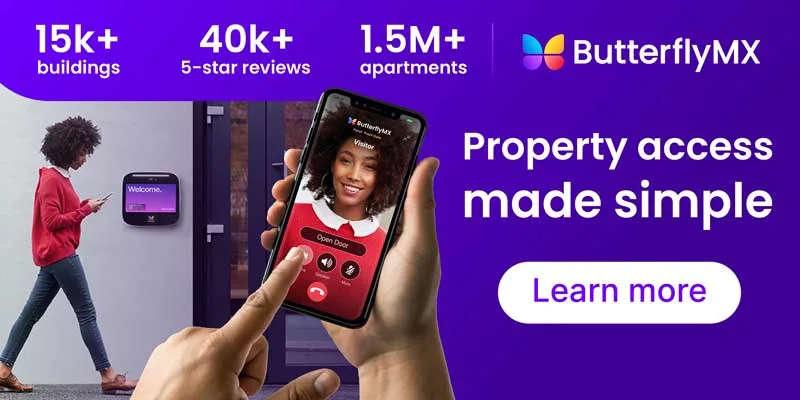Key takeaways
- Wireless apartment intercom systems have grown in popularity over the years because they offer modern features that multifamily properties need, such as smartphone-based access and remote management.
- While wireless intercoms are primarily used at office buildings and apartments, they’ve also found uses at gated communities, condos, and student housing.
- When narrowing down your search for a wireless intercom system, think of your budget, the installation, and the entryway you’ll be installing the device.

Wireless apartment intercom systems come in a wide array of models with varying features and capabilities. With such a variety of options, choosing a system is difficult. Fortunately, we’ve created this guide to help you find the right system for your apartment building.
This guide goes over why wireless intercoms are so popular, who is using them, and how they compare to wired systems. You’ll also learn what features to prioritize when choosing an apartment intercom system, and we will answer some commonly asked questions about these devices.
Navigate this buyer’s guide:
- Why are wireless apartment intercom systems popular?
- Who are wireless intercom systems for?
- Wired vs. wireless apartment intercoms
- How do you choose a wireless apartment intercom system?
- Wireless apartment intercom FAQs
- Why our solution is the right fit for your apartment building
Why are wireless apartment intercom systems popular?
Wireless apartment intercom systems have grown in popularity over the years thanks to their many advantages over traditional wired solutions.
Generally, wireless intercom systems are future-proof, meaning they’re less likely to become obsolete or fail after installation. They utilize modern technologies to stay updated and gain new features long after installation.
Here are some other reasons why wireless apartment intercom systems are so popular:
- Smartphone credentials. A large majority of wireless apartment intercoms support smartphones as a credential, preventing you from assigning key cards, fobs, or traditional keys to tenants or employees. Rather, users can open up a mobile app on their smartphone to enter the property or even let their guests inside.
- Easy installation. As you can expect, installing a wireless intercom is much easier and cost-effective. While these systems aren’t entirely wireless, the few connections they require are not invasive, so you’ll save time, money, and hassle when it comes to installation.
- Remote management. Due to the cloud-based video intercom infrastructure, you or your staff can easily manage access permissions, review audit logs, and more, no matter where you’re located. Using the mobile app or online dashboard gives you and your staff full control over property access, whether on-site or off.
- Remote access. Residents also benefit from the intercom’s use of the cloud by offering remote access. Your residents can grant their friends, family, service workers, and delivery drivers access to the building from a mobile app. This way, residents don’t always have to be on-site to let their guests in or go down to the front door, creating a better resident experience.
- Integrations. Wireless apartment intercoms can integrate with other software and hardware you may already use. By integrating your door entry system with fire alarms, security cameras, PMS, and other features, you create a centralized platform that’s more effective at securing the property and easier to manage.
Who are wireless intercom systems for?
Despite wireless intercom systems being designed for apartment buildings, they’ve found uses in other multifamily properties:
Student housing
In student housing environments, residents are younger, so they expect more tech-focused amenities, such as a wireless intercom system. These devices not only meet the expectations of student renters but also enhance their living experience.
After all, students are bound to have a lot of friends and family over. Not to mention, younger people are ordering more and more online, so you’ll need a system that can easily manage package deliveries.
With all that said, a student housing video intercom is the ideal solution, enabling students to let themselves, guests, and delivery drivers into the property via their phones. Meanwhile, your intercom maintains security and prevents unauthorized access, which is crucial for student housing.
Gated communities
Wireless intercom systems are ideal for gated communities when installed at the gate entrance. Gate intercoms offer a more streamlined access solution than traditional telephone entry systems because drivers can open the gate remotely using their smartphones.
As a result, drivers can get into the community faster without typing in a code or presenting a physical credential. This faster form of entry reduces the chances of tailgating your community may suffer from. Additionally, intercoms reduce traffic at gates because residents can grant their guests access remotely upon receiving their request.
Condos
Condominiums benefit from wireless intercoms by simplifying the process of granting guest and delivery drivers access to the property. By reducing reliance on physical credentials, you can increase the security and safety of homeowners while adding convenience to their daily lives.
For instance, some wireless condo intercom systems support visitor passes. This feature enables a homeowner to send a temporary digital key to a service worker, such as a house sitter. Then, when out of town for the week, the house sitter can use the key to gain independent access to the property and check on the homeowner’s condo.
Homeowners can customize the key to work only once or at certain times of the day and week. They can also revoke the key at any time. As a manager, you’ll also be able to revoke visitor passes as you see fit, offering greater safety for your condo building.
Senior communities
As more seniors adopt smartphones, wireless apartment intercom systems become increasingly more important. These devices provide the level of security seniors want in a community while still being user-friendly and intuitive.
At the same time, a wireless intercom gives seniors the flexibility to let in their families or healthcare providers remotely. As such, seniors won’t have to worry about walking to the front door to let in their guests. Rather, they can do it from their smartphone or even their traditional phone. For traditional phones, seniors simply have to press “9” to let in their guests remotely, ensuring all community members can take advantage of the intercom.
Wired vs. wireless apartment intercoms
The most obvious difference between wired and wireless apartment intercom systems comes down to wiring. However, there are a lot of other differences between these systems.
Overall, here is how wired and wireless apartment intercoms compare:
Wired apartment intercom: pros and cons
Pros:
- More reliable connection. Wired intercoms are less likely to experience connectivity issues because it doesn’t rely on WiFi or cellular signals.
- Well-established technology. These types of intercoms have been around for decades, making them reliable investments.
- Doesn’t require internet. Most wired apartment intercoms don’t rely on the internet to transmit data. So, if your property doesn’t have a solid internet connection, this system may be more suitable for an entry system.
Cons:
- Intrusive installation. Unlike their wireless counterparts, wired intercoms are extremely intrusive when it comes to installation. You’ll have to run wiring throughout the entire apartment building, which is labor-intensive and time-consuming.
- High costs. Due to the complexity and increased labor, the installation of wired apartment intercoms is much higher. Not to mention, these costs only grow based on the age and size of your building.
- Difficult to upgrade. Future upgrades will be more expensive because they require rewiring and may not integrate with newer technologies.
- In-unit hardware. Wired systems take advantage of in-unit hardware so that residents can speak with guests at the intercom. However, these devices are redundant when all of your residents have smartphones that can serve the same purpose.
- More maintenance. Extensive wiring and hardware require more maintenance than you may expect. These systems also cannot receive updates from the manufacturer remotely, so you’ll need a technician to come on-site to update it manually.
Wireless apartment intercom: pros and cons
Pros:
- Simple installation. Wireless apartment intercom systems require fewer wired connections and don’t utilize in-unit hardware. This means the installation process is faster, less invasive, and faster.
- Scalable and future-proof. With little to no wiring, wireless intercom systems are ideal for scaling your property and reduce the need for upgrades in the future. These systems are ideal for properties looking to invest in a single solution and stick with it for years to come, as it easily scales as your property does.
- Lower costs. While wireless intercoms typically have ongoing subscription costs, they are cheaper to install and maintain over time. You won’t have to maintain extensive wiring or in-unit hardware, cutting costs significantly and reducing disruptions.
- Less maintenance. Expect your system to require less maintenance since most of it can be done remotely from the manufacturer. You can even expect new features and functionality as it’s updated over time.
- Remote access. By leveraging the cloud, wireless apartment intercom systems enable you and your resident to grant remote access while at home or anywhere else in the world, maximizing convenience.
Cons:
- Reliance on the internet. Wireless apartment intercom systems rely on the internet, so your system won’t fully function if it goes down. However, your residents can still enter the property using their unique PIN codes, and guests can use their visitor pass that was created before the outage.
- Subscription costs. Most wireless apartment intercoms require an ongoing subscription that gives you access to an online dashboard to manage your system. While this model may not be suitable for all properties, it offers numerous advantages, such as cloud storage, software updates, new features, remote access, and high-quality customer service.
How do you choose a wireless apartment intercom system?
Before making a decision on a wireless apartment intercom system, there are some factors to consider first. After all, you require a solution that best fits your and your residents’ security needs.
For the best experience with wireless apartment intercoms, consider:
- Budget. Apartment intercoms vary widely in price, but it’s critical you find a system that is cost-effective for your property. Most importantly, don’t forget to consider the costs associated with installation, as it will also have an impact on your budget.
- Installation. Some apartment intercom systems are easier to install than others. For example, wired intercom systems will take a lot of time to install because they are more complex. With this in mind, choose a system that won’t set you back when it comes to upgrading your property.
- Property. The size of your property should influence the type of system you choose. If your property is large, with hundreds of units, a wireless apartment intercom system is best because it won’t require extensive wiring throughout the building. As a result, you’ll save a lot on installation.
- Entryway. Apartment intercoms can be installed at traditional doorways, but they can also be placed at gates or garages. Keep location in mind when considering what type of system is best because it’ll impact costs and installation. For the best results, choose the system that will meet your needs without drastically affecting costs or installation.
- Internet access. Lastly, ensure the location where you plan to install your intercom receives dependable internet service. While some wireless intercom systems can use WiFi, many still require a hard-wired connection. Conversely, wired intercom systems require a wired connection regardless.
Learn how the ButterflyMX ecosystem works:
Wireless apartment intercom FAQs
- How do wireless apartment intercom systems work?
- Are wireless intercoms secure?
- Do wireless intercoms work during power or internet outages?
- How far can wireless intercoms transmit?
How do wireless apartment intercom systems work?
Wireless apartment intercom systems work by using the internet to receive and verify credentials before granting access to a user.
More specifically, there are three major components a wireless intercom system utilizes to function:
- Base station. Located at the entryway, the base station acts as the brains of the system. The base station is what determines if a user may enter based on the credentials provided. It communicates with substations and the door release to verify credentials and unlock the entryway.
- Substation. Wireless intercom systems primarily use smartphones as substations because they reduce installation costs and are significantly more convenient for users. Substations act as the credentials for users, allowing them to grant access for themselves or for guests remotely.
- Door release. As the component physically secures the entryway, the door release grants access once it receives a signal from the base station when authorized credentials are provided. Then, the user has a limited amount of time to enter before the entry is secured again.
Are wireless intercoms secure?
Generally yes, wireless intercoms are secure when they are properly maintained and updated with the latest firmware. Most wireless apartment intercom systems follow encryption protocols to prevent security breaches or interference with other signals. Thus, your residents’ conversations with visitors through the intercom won’t be intercepted.
Nonetheless, the safety of your wireless intercom depends on the manufacturer’s diligence in updating and maintaining its firmware and software.
Do wireless intercoms work during power or internet outages?
It depends on the system.
In most cases, wireless intercoms, unless powered by a battery, do not work during a power outage.
Meanwhile, many intercom systems are designed to continue working during an internet outage. Certain intercom features, such as PIN codes and Visitor Passes (as long as they were created before the outage), will continue to work.
Of course, it’s always best to check with the system’s manufacturer to learn more about the functionality of your intercom.
How far can wireless intercoms transmit?
Wireless intercoms, when using the internet, can transmit calls over unlimited distances. Since the signal is sent via the internet or cellular network, smartphones can receive notifications from the intercom no matter where they are. This allows residents to grant their guests, delivery drivers, or service providers access remotely without interference.
Why our solution is the right fit for your apartment building
Established in 2014, ButterflyMX is a cloud-based access control company. Our flagship product, the Video Intercom, is a wireless apartment intercom system that simplifies access for your residents, staff, visitors, and delivery drivers.
Since our inception, ButterflyMX has been installed in more than 15,000 buildings and has garnered over 40,000 five-star reviews. Our products empower residents and staff to use their smartphones to enter the building and access areas throughout the entire property.
When it comes to our Video Intercom System, you’ll benefit from:
- Our user-friendly mobile app that lets manage property access and residents can use it to see and speak with their guests before granting them access.
- A built-in camera with a 156° field-of-view for capturing door entries and enabling residents to get a clear view of guests when requesting access.
- A detailed audit log that features time- and date-stamped photos of door entries that allow you to more effectively resolve security investigations.
- The built-in directory that lets guests or delivery drivers notify them of their arrival, which can be customized to display resident names or unit numbers.
- Delivery PINs, which give independent access to delivery drivers so that your residents no longer experience missed or stolen packages.
- Our support of multiple credentials; choose from our highly-rated mobile app, PIN codes, key cards, or fobs based on your security preferences.
- The ButterflyMX OS is accessible via our mobile app or online dashboard, giving you the ability to manage permissions, review entry logs, and integrate your system with other systems no matter where you’re located.







